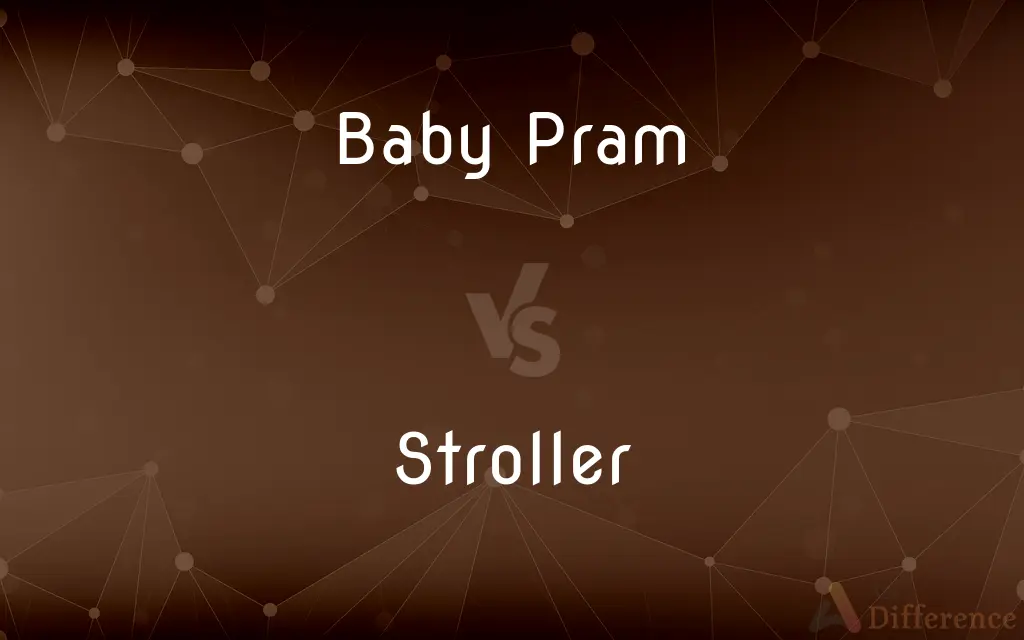Baby Pram vs. Stroller — What's the Difference?
Edited by Tayyaba Rehman — By Fiza Rafique — Published on November 3, 2023
A Baby Pram is a wheeled vehicle for newborns who can't sit, while a Stroller is designed for sitting infants and toddlers, often more compact and foldable.

Difference Between Baby Pram and Stroller
Table of Contents
ADVERTISEMENT
Key Differences
A Baby Pram is specifically designed with the comfort and safety of a lying newborn in mind, while a Stroller typically provides a seat that supports older infants and toddlers who are capable of sitting upright. The Baby Pram's design commonly embodies a more sizeable and secure bassinet, while the Stroller often prioritizes a blend of safety and compactness suitable for travel and maneuverability.
Baby Prams typically offer a more robust support system, particularly designed to cradle a newborn in a lying position, ensuring optimal support and safety. Strollers, conversely, allow the child to sit up, observe their surroundings, and usually accommodate older infants and toddlers, thus offering less overarching support.
Baby Prams, with their more ample and encompassing design, are less portable and often do not fold as compactly as Strollers. Strollers, with their design being more geared towards travel and convenience, often feature the ability to be folded and stored with relative ease, providing a crucial aspect of portability.
Baby Prams frequently feature a cover to shield the baby from various external elements like wind, sunlight, or rain due to their open and exposed bassinet design. On the other hand, Strollers might also provide a canopy but are generally more open to enable the child to explore their visual surroundings freely.
Baby Prams, while excellently safeguarding newborns, may not serve utility beyond the initial months. In contrast, Strollers, given their versatile design for slightly older infants and toddlers, often enjoy a longer useful life, adapting to the growing child’s needs.
ADVERTISEMENT
Comparison Chart
Suitable Age
Newborns
Older infants and toddlers
Positioning
Lying down
Sitting upright
Portability
Generally less portable and compact
More compact and often foldable
Visibility
Often enclosed
Allows child to observe surroundings
Utility Duration
Limited to early months
Usable for several years
Compare with Definitions
Baby Pram
Structured to support a lying position.
The baby pram provided ample support for the sleeping infant.
Stroller
Designed for transporting sitting children.
He sat curiously observing his surroundings from the stroller.
Baby Pram
Generally not foldable or compact.
Navigating the mall was a bit challenging with the sizable baby pram.
Stroller
Typically foldable and compact.
The stroller conveniently folded, making travel efficient and easy.
Baby Pram
Often enclosed to shield the baby.
The baby pram’s cover protected the infant from the summer sun.
Stroller
Suitable for infants to toddlers.
As she grew, her stroller adapted to her changing size and posture.
Baby Pram
Wheeled vehicle designed for newborn transport.
She gently placed the newborn in the baby pram and strolled around the park.
Stroller
Offers extended usability through childhood.
The stroller served its purpose well into his toddler years.
Baby Pram
Primarily for the earliest months of infancy.
She utilized the baby pram until he was able to sit upright.
Stroller
Allows children to engage with their surroundings.
She gleefully interacted with her surroundings from her stroller.
Stroller
One who strolls
Elderly strollers in the park.
Stroller
A carriage with three or four wheels and often having a retractable hood, that is pushed while walking to transport a infant or young child.
Stroller
An itinerant actor or performer.
Stroller
A vagabond.
Stroller
A seat or chair on wheels, pushed by somebody walking behind it, typically used for transporting babies and young children.
Stroller
One who strolls.
Stroller
A vagrant.
Stroller
Men's semiformal daytime dress comprising a grey or black single- or double-breasted coat, grey striped or checked formal trousers, a grey or silver necktie, and a grey, black or buff waistcoat.
Stroller
One who strolls; a vagrant.
Stroller
Someone who walks at a leisurely pace
Stroller
A small vehicle with four wheels in which a baby or child is pushed around
Common Curiosities
What is a "Stroller"?
A "Stroller" (also known as a buggy in some places) is a foldable chair-like carriage designed for children who can sit up, with the child facing forward.
How does a "Baby Pram" differ from a "Stroller"?
The primary difference is the positioning of the child. In a pram, the baby usually lies down facing upwards or towards the pusher, while in a stroller, the child sits up facing forward.
Are "Strollers" suitable for newborns?
Some strollers are designed to recline fully and can be used for newborns. However, traditional strollers are best suited for babies who can hold their heads up.
Why would one choose a "Baby Pram" over a "Stroller"?
Prams are ideal for newborns and younger babies who need to lie flat for spine development and are not yet able to sit up.
What is a "Baby Pram"?
A "Baby Pram" (short for "perambulator") is a wheeled carriage designed to carry an infant or young baby who typically lies down while facing the person pushing.
How should one choose between a "Baby Pram" and a "Stroller"?
The choice depends on the child's age and needs. Prams are more suitable for younger babies, while strollers are ideal for older infants and toddlers.
Can a "Baby Pram" be converted to a "Stroller"?
Some modern prams are designed to be convertible and can be adjusted to function as strollers when the child is older and can sit up.
Is there a weight limit for "Strollers"?
Yes, strollers typically have a weight limit, which varies by design and brand. It's essential to check the manufacturer's guidelines.
Do both "Baby Prams" and "Strollers" come with safety features?
Yes, both typically include safety features such as harnesses, brakes, and sometimes canopies for protection against sun or rain.
Can "Strollers" be used for jogging?
Specific strollers, known as "jogging strollers," are designed for jogging. They usually have three wheels and enhanced suspension for a smoother ride.
Why are "Strollers" popular for toddlers?
Strollers are lightweight, foldable, and designed for mobility, making them convenient for parents to navigate crowded places or go for walks with toddlers.
Is it easy to travel with a "Baby Pram" or "Stroller"?
Strollers are generally more travel-friendly due to their foldability. However, many modern prams are also designed to be compact and travel-friendly.
How do "Baby Prams" and "Strollers" handle different terrains?
Some prams and strollers are designed with larger wheels or enhanced suspension to handle uneven terrains, like cobblestones or trails. However, typical models are best suited for smooth paths.
Do "Baby Prams" and "Strollers" come with storage spaces?
Many prams and strollers come with storage baskets or pockets, allowing parents to store essentials like diapers, wipes, and snacks.
Is it necessary to buy both a "Baby Pram" and a "Stroller"?
Not necessarily. Depending on the family's needs and budget, they might opt for a convertible model that serves both purposes or choose one that fits their immediate needs.
Share Your Discovery

Previous Comparison
SnRNA vs. SnoRNA
Next Comparison
Canon vs. NikonAuthor Spotlight
Written by
Fiza RafiqueFiza Rafique is a skilled content writer at AskDifference.com, where she meticulously refines and enhances written pieces. Drawing from her vast editorial expertise, Fiza ensures clarity, accuracy, and precision in every article. Passionate about language, she continually seeks to elevate the quality of content for readers worldwide.
Edited by
Tayyaba RehmanTayyaba Rehman is a distinguished writer, currently serving as a primary contributor to askdifference.com. As a researcher in semantics and etymology, Tayyaba's passion for the complexity of languages and their distinctions has found a perfect home on the platform. Tayyaba delves into the intricacies of language, distinguishing between commonly confused words and phrases, thereby providing clarity for readers worldwide.











































